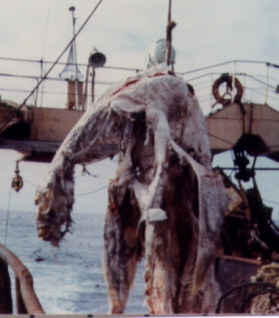Tuesday, February 25, 2014
The Zuiyo-Maru Creature
In 1977, the Zuiyo-Maru caught itself a sea monster. This Japanese trawler was looking for mackerel -- but what it found in its net was something else entirely. The creature was long dead and badly decomposed. Most of its flesh had rotted away, and its skeleton was clearly visible. Still, the animal looked like nothing else on earth. It was thirty feet long -- too big to be anything but a shark or whale. Yet it resembled neither. Its most distinguishing traits were its long neck and large fins -- which made it, more than anything, resemble a plesiosaur.
Unfortunately, the Zuiyo-Maru carcass was never brought to shore. Concerned it would spoil his fish, the captain had it tossed overboard -- after the crew took photographs. One of these (seen above) was widely publicized as evidence of surviving plesiosaurs. It caused a media sensation, and sparked the interest of countless cryptozoologists. According to recent studies, though, it's not a reptile at all. It seems most likely that the Zuiyo-Maru caught a dead basking shark.
If you've ever seen a basking shark, you're probably very skeptical. They're bulky, thick-headed, giant-mouthed filter-feeders -- in short, they look nothing like the picture above. The key point to note, though, is how basking sharks decay. Most animals, after death, "fall apart" in a specific sequence. The study of decomposition is called taphonomy, and it can tells us a lot about the Zuiyo-Maru's find.
A basking shark's corpse distinegrates head-first. The giant lower jaw sloughs off, separating from the rest of the body. The fat, fleshy portions slide away from the skeleton -- leaving an emaciated carcass behind. This carcass seems to have a long "neck" with a small head -- but in fact, this "head" is just the brain case. The animal's jaws are long gone; in effect, the corpse has been decapitated. A dead basking shark is a dead ringer for this cryptid.
This idea didn't convince everyone -- some were sure that the Zuiyo-Maru had found a sea serpent. They pointed to purported discrepancies seen in the photograph -- features that a basking shark shouldn't have. Eventually, though, testing of the monster's flesh revealed its identity. According to amino acid tests, the carcass was indeed a shark. Could plesiosaurs still be out there? Many cryptozoologists think so. But the Zuiyo-Maru's monster isn't one of them.
Read more about the Zuiyo-Maru Creature:
http://paleo.cc/paluxy/plesios.htm
http://bizarrezoology.blogspot.com/2013/10/zuiyo-maru-carcass-shark-or-unknown.html
http://frontiersofzoology.blogspot.com/2013/12/zuiyo-maru-addendum-and-rebuttal.html
Image (public domain) from http://upload.wikimedia.org/wikipedia/en/4/4e/Zuiyo_Maru.jpg
Subscribe to:
Post Comments (Atom)

No comments:
Post a Comment